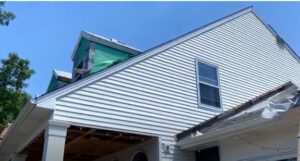 Pitched roofs are a popular choice for homeowners in Australia due to their numerous benefits. Unlike flat roofs, pitched roofs have a slope, which can offer a range of advantages in terms of durability, energy efficiency, and aesthetic appeal.
Pitched roofs are a popular choice for homeowners in Australia due to their numerous benefits. Unlike flat roofs, pitched roofs have a slope, which can offer a range of advantages in terms of durability, energy efficiency, and aesthetic appeal.
Benefits of a pitched roof in Australia
Here are some of the benefits of a pitched roof in Australia:
- Durability: Pitched roofs are more durable than flat roofs, as they are better able to withstand harsh weather conditions such as heavy rain, strong winds, and hail. The slope of the roof helps to shed water quickly, reducing the risk of leaks or water damage.
- Energy efficiency: Pitched roofs can be more energy efficient than flat roofs, as the slope allows for better ventilation and insulation. This can help to keep the interior of the building cooler in summer and warmer in winter, reducing the need for air conditioning or heating.
- Aesthetic appeal: Pitched roofs offer a classic and timeless look, making them a popular choice for many Australian homeowners. They can also offer more design flexibility, with a range of styles available to suit different architectural styles.
- Increased property value: A pitched roof can increase the value of a property, as it is often seen as a desirable feature by potential buyers. This can make it a worthwhile investment for homeowners looking to increase the resale value of their property.
Pitched roof materials in Australia
There are a variety of materials that can be used for pitched roofs in Australia, including:
- Clay tiles: Clay tiles are a popular choice for pitched roofs due to their durability, energy efficiency, and aesthetic appeal. They are available in a range of colors and styles, making them a versatile choice for different architectural styles.
- Concrete tiles: Concrete tiles are a cost-effective alternative to clay tiles, offering similar benefits in terms of durability and energy efficiency. They are also available in a range of colors and styles.
- Colorbond steel: Colorbond steel is a popular choice for pitched roofs in Australia, offering durability, energy efficiency, and design flexibility. It is available in a range of colors, making it a versatile choice for different architectural styles.
Maintenance requirements for pitched roofs
 Regular maintenance is essential to keep a pitched roof in good condition and prevent any damage or leaks. Here are some of the maintenance requirements that should be followed for pitched roofs in Australia:
Regular maintenance is essential to keep a pitched roof in good condition and prevent any damage or leaks. Here are some of the maintenance requirements that should be followed for pitched roofs in Australia:
- Clearing debris: It is important to regularly clear any debris that may accumulate on the roof, such as leaves, twigs, or branches. This debris can clog up gutters and downpipes, leading to water buildup and potential leaks.
- Regular inspections: Pitched roofs should be inspected at least twice a year to check for any signs of damage or wear and tear. Any issues should be addressed promptly to avoid further damage.
- Prompt repairs: Any damage to the roof, such as cracked tiles or missing shingles, should be repaired promptly. These issues can quickly worsen if left unattended, leading to more severe damage or leaks.
- Cleaning: Pitched roofs should be cleaned regularly to remove any dirt or debris that may have accumulated. This can be done using a pressure washer or by hand with a soft-bristled brush.
Conclusion
In conclusion, pitched roofs offer a range of benefits for homeowners in Australia, including durability, energy efficiency, aesthetic appeal, and increased property value. There are a variety of materials available for pitched roofs, including clay tiles, concrete tiles, and Colorbond steel.
Regular maintenance is essential to ensure that a pitched roof remains in good condition and prevents any damage or leaks. By following these maintenance requirements and choosing the right materials, homeowners can enjoy the many benefits of a pitched roof in Australia.